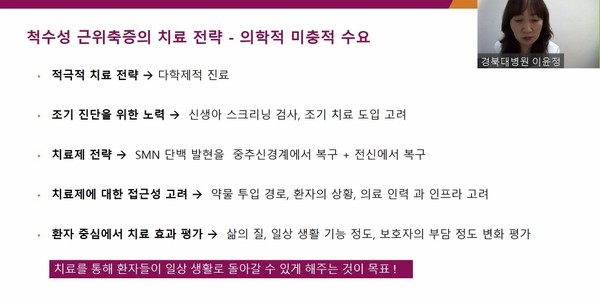“Domestic patients who receive insurance benefits for the treatment of spinal muscular atrophy (SMA) are already symptomatic. However, if symptoms are found, the disease has progressed to some extent, and the damage cannot be recovered even with treatment. Therefore, it is most important to diagnose and treat SMA early through neonatal screening so that pediatric patients can grow almost normally.”
So said professor Lee Yoon-jeong at the Pediatrics Department of Kyungpook National University Hospital at a press conference on Evrysdi, held by Roche on Tuesday.

SMA is a rare hereditary neuromuscular disease. In SMA patients, muscles of the entire body gradually weaken due to loss of motor nerves, caused by a deficiency of survival motor neuron (SMN) protein. The disease has a systemic impact, affecting the muscles for respiration and heart bests, skeletal muscles, joints, and the automatic nervous system.
SMA can occur at any point in life, from infancy to adulthood. Patients with Type 3 SMA, which appears after 18 months, have an almost normal life expectancy. Thus, physicians should have a treatment strategy to manage the disease across all age groups constantly.
Lee said SMA patients are likely to experience scoliosis due to weakened muscles that sustain the spine.
She said that patients whose spines are curved could not receive the spinal cavity treatment, so there is a high unmet medical need for other treatment methods.
According to studies, scoliosis occurs in about 60-90 percent of Type 1 and 2 SMA patients and 50 percent of Type 3 SMA patients who cannot walk.
Lee went on to say that with the breakthrough treatments in recent years, SMA patients could maintain motor function and daily life if they receive treatment early. “Now is the time to improve the overall treatment environment so that patients can receive customized treatment according to their age and physical condition,” she said.
According to Lee, untreated SMA leads to reduced life expectancy depending on the severity of the disease and loss of motor function over time.
Patients with the most severe Type 1 SMA have a rapid decrease of motor neuron function within one to two weeks after birth and most pediatric SMA patients show a 90 percent or more reduction in motor function within six months.
Clinical symptoms of SMA indicate that the disease has already progressed to some extent, and the resulting symptoms are irreversible even with treatment.
Lee emphasized the importance of neonatal screening to diagnose SMA early and treat patients to grow almost normally. “This will eventually relive the psychological and physical burden for patients and their guardians, as well as reduce subsequent medical costs,” she added.
Lee also proposed making systematic treatment strategies, enhancing patient access to therapies, establishing an early diagnosis system, and using multiple evaluation measures tailored to the patient’s condition.
“To change treatment strategies according to clinical symptoms, we need multidisciplinary care,” Lee said. To do so, physicians should form a specialist team consisting of doctors from pediatrics, orthopedic surgery, neurosurgery, anesthesia, digestive and nutrition, social work team, critical care team, and psychiatry, she said.
As many treatments have been developed with different mechanisms of action, administration methods, and administration cycles, people also need to improve access to these therapies and develop a biomarker to monitor treatment response, she added.
“It will also be necessary to evaluate the drug from the perspective of patients or their families, such as how much the changes in the scores shown by the drug in clinical trials changed the patient's quality of life, daily life function, and the financial burden of the caregiver,” she said.

